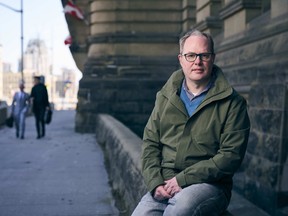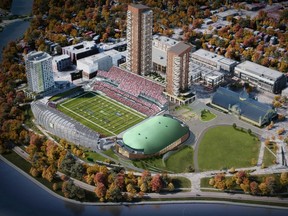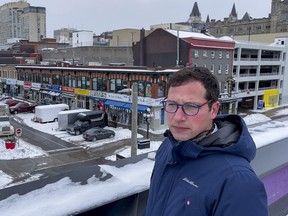Is Lansdowne killing the ByWard Market?
The civic tug-of-war between Lansdowne Park and the ByWard Market is a contest for hearts, minds and dollars that is shaping the future of two of Ottawa’s prime attractions.

Article content
In the decade since a renovated Lansdowne Park opened to visitors in August 2014, the 40-acre venue has steadily drawn visitors, vendors and investment dollars away from the ByWard Market.
The City of Ottawa poured $210 million into the first redevelopment, and later this year, council will decide whether to double-down on Lansdowne with another $419 million-plus investment to modernize its sports facilities.
The Market, too, has had a redevelopment plan on the table since January 2021. But the ByWard Market Public Realm Plan contains no funding mechanism and relies on federal, provincial and public-private partnerships to finance its $129 million worth of improvements.
For four years, they have largely gone unfunded.
In December, the Ontario government announced an $11.8 million contribution to the Market makeover plan to pedestrianize William Street, renovate ByWard Market Square and improve some basic infrastructure.
It’s all part of a civic tug-of-war between Lansdowne Park and the ByWard Market — a contest for hearts, minds and dollars that is shaping the future of two of Ottawa’s prime attractions.
Right now, it seems, the ByWard Market is losing that contest.

Ottawa architect and writer Toon Dreessen, president of Architects DCA, says all of the city’s energies and intellectual capital are being spent on Lansdowne 2.0.
“All of this has all been focused on Lansdowne, and the Market has been completely sidelined,” he contends. “All of our funding, and all of our capacity for dealing with a grand public space, has been focused on Lansdowne.
“We’re somehow OK with spending half a billion dollars on Lansdowne, but the Market plan that was costed out was a quarter of that.”

As an exercise, he says, local residents should imagine what Ottawa would look like if the city spent some of the Lansdowne 2.0 money on the ByWard Market, both on its physical infrastructure and on its homelessness problem. It’s possible, he says, that “something incredible” could result.
“But that’s just not on the radar, and that, I think is really sad,” he says.
Rideau-Vanier Coun. Stéphanie Plante says the “economic case” for investing in the ByWard Market is strong — and is starting to gain traction.
Plante said the Market represents the second largest source of municipal property taxes in the city — behind only downtown Ottawa — with more than 600 businesses. Host to almost 6,000 hotel rooms, it also receives the lion’s share of tourism.
The ByWard Market District Authority says there were 22 million visits to the Market in 2024, up 19 per cent from the previous year. Lansdowne Park received about 4 million visitors in 2024.
“We really are an economic backbone for the city,” argues Plante. “We need to be treated like it.”
ByWard Market and Lansdowne Park have co-existed since 1868 when the Ottawa Agricultural Society acquired a plot of land next to the Rideau Canal, east of Bank Street, as a fairground.
Lansdowne was then well-removed from the city’s population centre, and posed little threat to the well-established ByWard Market, which served as the commercial and retail hub of the city.
Even after the fairground expanded and played host to the annual Central Canada Exhibition, it was mostly a seasonal venue for military exercises, fairs, concerts, sporting events and political conventions.
Lansdowne and the Market played distinct, complementary roles in civic life.
By the 1990s, Lansdowne Park was in desperate shape: The Aberdeen Pavillion had been condemned and engineers said its roof was in danger of collapse. The Horticulture Building was also being readied for the wrecking ball.
But the buildings were saved in an 11th-hour compromise orchestrated by a then-rookie councillor named Jim Watson.

It didn’t stop Lansdowne Park’s decline. The football team that succeeded the Rough Riders, the Ottawa Renegades, left in 2006. In October 2007, engineers found cracks in the south side stands, which were subsequently demolished. The Super Ex left in 2010.
It all led to a protracted redevelopment debate that ultimately led to the current edition of Lansdowne Park, which features bars, restaurants, festivals, sports, destination shopping (Sporting Life) and food stores (Whole Foods Market), music and food festivals, a farmers’ market and a Christmas Market.
The new Lansdowne has emerged as more of a direct competitor to the ByWard Market.
In 2015, the seasonal farmer’s market at Lansdowne Park became a year-round attraction. For the next decade, produce vendors steadily left the ByWard Market for Lansdowne and for other seasonal markets in Barrhaven, Westboro, Orleans and Ottawa East.
The Ottawa Christmas Market at Lansdowne Park has grown exponentially every year since its launch in 2019. This year, the Christmas Market lasted seven weeks — a two-week extension of its previous schedule — and attracted 423,000 visitors.
Attendance was up by more than 160,000, and the crowds regularly caused traffic jams on Bank Street.
The ByWard Market fought back with a small, artificial skating rink on William Street that often sat empty.

Lansdowne has also enjoyed a bump from the Professional Women’s Hockey League, which consistently brings more than 6,000 fans to its home games at TD Place Arena.
In addition to more parking options, Lansdowne also has the advantage of large spaces — the Aberdeen Pavillion, the Horticulture Building, Aberdeen Plaza, the Great Lawn — that can be used to host a variety of programming.
ByWard Market’s public realm plan envisions new, programmable public spaces that would allow it to better compete with Lansdowne. It calls for the Clarence Street parkade to be redeveloped as a “destination” building and for the creation of a “flexible” York Street plaza, between Sussex Drive and the ByWard Market Building. The plaza would host special events sometimes and cars at other times.
The plan also calls for new gateways into the ByWard Market, the reinvention of ByWard Market Square and a pedestrian-only William Street, from Rideau Street to Clarence Street.
But the project needs money, and so far at least, it has taken a backseat to the redevelopment of Lansdowne Park.

What’s more, the redevelopment of LeBreton Flats, and the construction of a new home for the Ottawa Senators, might soon knock the ByWard Market further down the city’s priority list.
“I don’t think it’s a frustration,” says Zachary Dayler, executive director of the ByWard Market District Authority (BMDA). “I think it’s a challenge that we need to look at and say, ‘OK, how do we put the prominence that is applied to LeBreton, that’s applied to Lansdowne, and also apply it to ByWard.”
Dayler said the province’s $11.8 million investment in the ByWard is “a strong signal that future and further investments will come.”

Former Rideau-Vanier ward councillor Mathieu Fleury shepherded the Market’s public realm plan through city council. He contends the city budget is big enough to accommodate the redevelopment of the ByWard Market alongside other projects, such as Lansdowne and LeBreton Flats.
He does not want to see one neighbourhood pitted against another.
“We have got to think about it comprehensively,” Fleury argues, “and if you think of a city like a body, the ByWard Market is its heart.”
Stéphanie Plante notes that Lansdowne is an entirely city-owned property, which simplifies decision-making about its redevelopment. About 20 per cent of properties inside the ByWard Market are owned by the National Capital Commission.
It’s also home to about 10 per cent of the city’s heritage buildings, the U.S. Embassy, several federal government buildings, an inter-provincial truck route, most of the city’s homeless shelters, and more than its share of opioid-related social chaos.
The city has invested in the Market’s safety and security. The Ottawa Police Service opened a Neighbourhood Operations Centre in the Rideau Centre in 2024 and launched an intensified policing strategy for Rideau Street and the ByWard Market.
All of it means, Plante says, that the ByWard Market is both complicated and iconic, and that progress demands partnerships. Plante recently met with federal officials to pitch a new investment in the Market, and she suggested money is on the table.
“I’m hoping there can be an announcement soon,” she says.
Plante also believes there’s opportunity for the ByWard Market as Lansdowne 2.0 unfolds. The massive project will turn Lansdowne into a construction site once again, which promises to disrupt business and events at the site for years to come.
The last time Lansdowne was a construction site, the farmers’ market moved to Brewer Park in Ottawa South.
This time, Plante intends to invite them to return to the ByWard Market.
“I would love to bring all of those farmers to the ByWard while they’re waiting to go back — and then keep them here.”
Our website is your destination for up-to-the-minute news, so make sure to bookmark our homepage and?sign up for our newsletters?so we can keep you informed.









Postmedia is committed to maintaining a lively but civil forum for discussion. Please keep comments relevant and respectful. Comments may take up to an hour to appear on the site. You will receive an email if there is a reply to your comment, an update to a thread you follow or if a user you follow comments. Visit our Community Guidelines for more information.